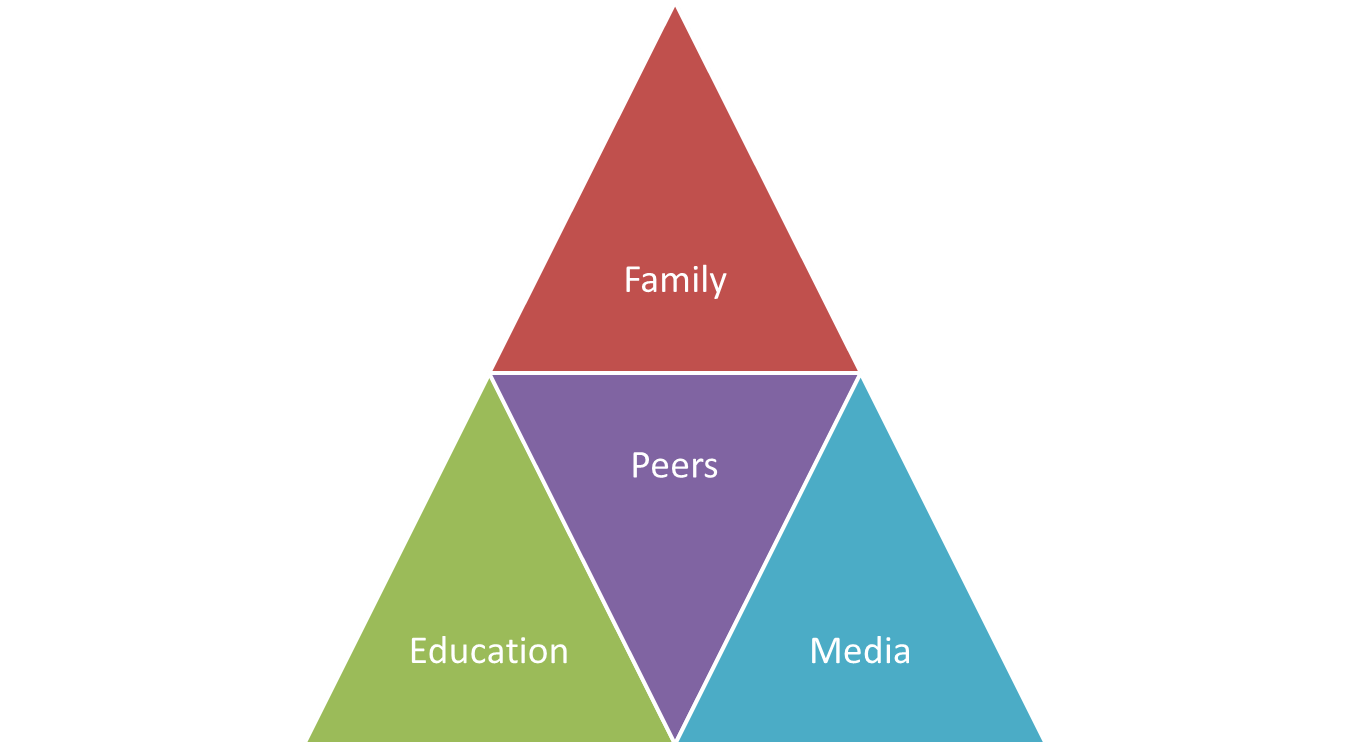Gender Enculturation Agents
Regardless of theory, observing, organization and learning about gender occurs through four major agents of socialization: family, education, peers and media. Each agent reinforces gender roles by creating and maintaining normative expectations for gender-specific behavior. Exposure also occurs through secondary agents such as religion and the workplace.

Family
Family is the first agent of socialization and enculturation. There is considerable evidence that parents socialize sons and daughters differently. A meta-analysis of research from the United States and Canada found that parents most frequently treated sons and daughters differently by encouraging gender-stereotypical activities (Lytton & Romney, 1991). Fathers, more than mothers, are particularly likely to encourage gender-stereotypical play, especially in sons. Parents also talk to their children differently based on stereotypes. For example, parents talk about numbers and counting twice as often with sons than daughters (Chang, Sandhofer, & Brown, 2011) and talk to sons in more detail about science than with daughters. Parents are also much more likely to discuss emotions with their daughters than their sons.
Girls may be asked to fold laundry, cook meals or perform duties that require neatness and care. It has been found that fathers are firmer in their expectations for gender conformity than are mothers, and their expectations are stronger for sons than they are for daughters (Kimmel, 2000). This is true in many types of activities, including preference of toys, play styles, discipline, chores, and personal achievements. As a result, boys tend to be particularly attuned to their father’s disapproval when engaging in an activity that might be considered feminine, like dancing or singing (Coltrane and Adams, 2008).
It should be noted that parental socialization and normative expectations vary along lines of social class, race, and ethnicity. Research in the United States has shown that African American families, for instance, are more likely than Caucasians to model an egalitarian role structure for their children (Staples and Boulin Johnson, 2004). Even when parents set gender equality as a goal, there may be underlying indications of inequality. For example, when dividing up household chores, boys may be asked to take out the garbage, take care of the yard or perform other tasks that require strength or toughness.
Peers
As noted earlier, peer socializations can also serve to reinforce gender norms of a culture. Children learn at a very young age that there are different expectations for boys and girls. When children do not conform to the appropriate gender role, they may experience negative consequences like criticism, bullying or rejection by their peers. Boys and young men are more likely to experience intense, negative peer responses when they do not follow traditional gender norms (Coltrane and Adams, 2008; Kimmel, 2000).

Education
The reinforcement of gender roles and stereotypes continues once a child reaches school age. Studies suggest that gender socialization still occurs in schools today, perhaps in less obvious forms (Lips, 2004). Teachers may not even realize that they are acting in ways that reproduce gender-differentiated behavior patterns but any time students are asked to arrange their seats or line up according to gender, teachers are reinforcing that boys and girls should be treated differently (Thorne, 1993). Even in levels as low as kindergarten, schools subtly convey messages to girls indicating that they are less intelligent or less important than boys.
For example, in a study involving teacher responses to male and female students, data indicated that teachers praised male students far more than they praised female students. Additionally, teachers interrupted girls more and provided boys with more opportunities to expand on their ideas (Sadker & Sadker, 1994). Schools often reinforce the polarization of gender by positioning girls and boys in competitive arrangements – like a “battle of the sexes” competition.
Media
In television and movies, women tend to have less significant roles and are often portrayed as wives or mothers. When women are given a lead role, they are often one of two extremes: a wholesome, saint-like figure or a malevolent, hypersexual figure (Etaugh and Bridges, 2003). Weisbuch and Ambady (2009) demonstrated that nonverbal behavior on television can communicate culturally shared attitudes and biases about women and ideal body images. Television commercials and other forms of advertising also reinforce inequality and gender-based stereotypes. Women are almost exclusively present in ads promoting cooking, cleaning, or child care-related products (Davis, 1993). Think about the last time you saw a man star in a dishwasher or laundry detergent commercial. In general, women are underrepresented in roles that involve leadership, intelligence, or emotional stability. In mainstream advertising, however, themes intermingling violence and sexuality are quite common (Kilbourne, 2000).
Gender inequality is pervasive in children’s movies (Smith, 2008). Research indicates that of the 101 top-grossing children’s movies released between 1990 and 2005, three out of four (75%) characters were male, only seven (7%) were near being gender balanced.

